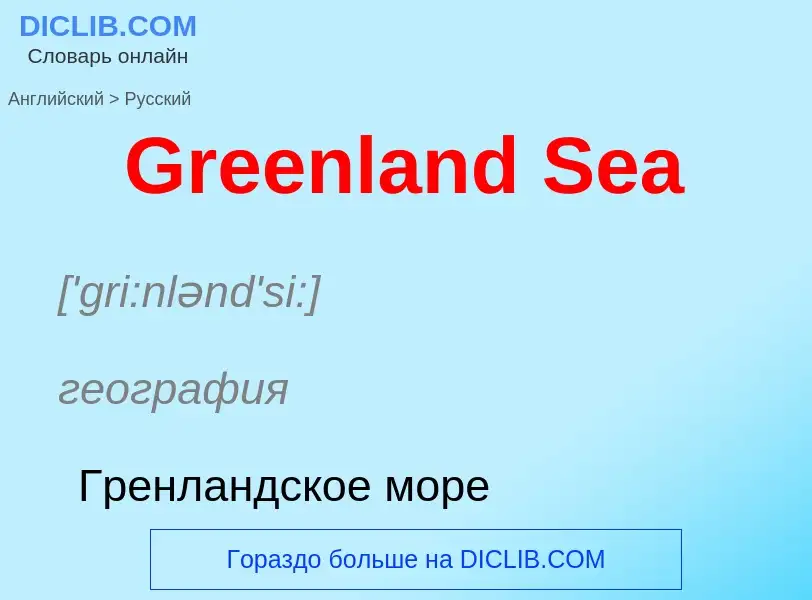Перевод и анализ слов искусственным интеллектом ChatGPT
На этой странице Вы можете получить подробный анализ слова или словосочетания, произведенный с помощью лучшей на сегодняшний день технологии искусственного интеллекта:
- как употребляется слово
- частота употребления
- используется оно чаще в устной или письменной речи
- варианты перевода слова
- примеры употребления (несколько фраз с переводом)
- этимология
Greenland Sea - перевод на русский
['gri:nlənd'si:]
география
Гренландское море
['gri:nlənd]
существительное
география
о-в Гренландия
['gri:nlənd]
общая лексика
лугопастбищное угодье
сенокосное угодье
луг
пастбище
сельское хозяйство
лугопастбищные угодь
существительное
сельское хозяйство
лугопастбищные угодья
Определение
2) Эгейское море
Википедия
1.jpg?width=120)
The Greenland Sea is a body of water that borders Greenland to the west, the Svalbard archipelago to the east, Fram Strait and the Arctic Ocean to the north, and the Norwegian Sea and Iceland to the south. The Greenland Sea is often defined as part of the Arctic Ocean, sometimes as part of the Atlantic Ocean. However, definitions of the Arctic Ocean and its seas tend to be imprecise or arbitrary. In general usage the term "Arctic Ocean" would exclude the Greenland Sea. In oceanographic studies the Greenland Sea is considered part of the Nordic Seas, along with the Norwegian Sea. The Nordic Seas are the main connection between the Arctic and Atlantic oceans and, as such, could be of great significance in a possible shutdown of thermohaline circulation. In oceanography the Arctic Ocean and Nordic Seas are often referred to collectively as the "Arctic Mediterranean Sea", a marginal sea of the Atlantic.
The sea has Arctic climate with regular northern winds and temperatures rarely rising above 0 °C (32 °F). It previously contained the Odden ice tongue (or Odden) area, which extended eastward from the main East Greenland ice edge in the vicinity of 72–74°N during the winter and acted as a key winter ice formation area in the Arctic. The West Ice forms in winter in the Greenland Sea, north of Iceland, between Greenland and Jan Mayen island. It is a major breeding ground of harp seal and hooded seal that has been used for seal hunting for more than 200 years.

1.jpg?width=200)

![[[Eyjafjörður]], the longest fjord in Northern Iceland, belongs to the Greenland Sea. [[Eyjafjörður]], the longest fjord in Northern Iceland, belongs to the Greenland Sea.](https://commons.wikimedia.org/wiki/Special:FilePath/Grenland Sea Dalvik.jpg?width=200)



![[[Sermiligaaq]]. Greenland has more than 60 settlements. [[Sermiligaaq]]. Greenland has more than 60 settlements.](https://commons.wikimedia.org/wiki/Special:FilePath/20190626 Harbor 0308 (48480740237).jpg?width=200)
![The United States has operated [[Pituffik Space Base]] since the 1950s. The United States has operated [[Pituffik Space Base]] since the 1950s.](https://commons.wikimedia.org/wiki/Special:FilePath/Aerial Picture Of Thule Air Base.jpg?width=200)
![special territories of the European Union]] (pre 31 January 2020) special territories of the European Union]] (pre 31 January 2020)](https://commons.wikimedia.org/wiki/Special:FilePath/EU OCT and OMR map en.png?width=200)
![[[Muskox]]en in Greenland [[Muskox]]en in Greenland](https://commons.wikimedia.org/wiki/Special:FilePath/Greenland-musk-ox hg.jpg?width=200)
![The [[Greenland Dog]] was brought from Siberia 1,000 years ago. The [[Greenland Dog]] was brought from Siberia 1,000 years ago.](https://commons.wikimedia.org/wiki/Special:FilePath/Greenland 377 (34999131992).jpg?width=200)
![Arctic sea ice]] is not shown. Arctic sea ice]] is not shown.](https://commons.wikimedia.org/wiki/Special:FilePath/Greenland 42.74746W 71.57394N.jpg?width=200)

![Norse]] Greenlanders records a marriage that took place in 1408 in the [[church of Hvalsey]], now the best-preserved Nordic ruins in Greenland. The married couple then travelled to Iceland, which is why the account has been preserved. Norse]] Greenlanders records a marriage that took place in 1408 in the [[church of Hvalsey]], now the best-preserved Nordic ruins in Greenland. The married couple then travelled to Iceland, which is why the account has been preserved.](https://commons.wikimedia.org/wiki/Special:FilePath/Hvalsey Church.jpg?width=200)
![Ilimmarfik]]'' university Campus in [[Nuuk]] Ilimmarfik]]'' university Campus in [[Nuuk]]](https://commons.wikimedia.org/wiki/Special:FilePath/Ilimmarfik.jpg?width=200)
![[[Tunumiit]] [[Inuit]] couple from [[Kulusuk]] [[Tunumiit]] [[Inuit]] couple from [[Kulusuk]]](https://commons.wikimedia.org/wiki/Special:FilePath/Kulusuk, Inuit couple (6822265499).jpg?width=200)
.jpg?width=200)
![Most Greenlandic villages, including [[Nanortalik]], have their own church. Most Greenlandic villages, including [[Nanortalik]], have their own church.](https://commons.wikimedia.org/wiki/Special:FilePath/Nanortalik church.jpg?width=200)
![[[Nive Nielsen]], Greenlandic singer and songwriter [[Nive Nielsen]], Greenlandic singer and songwriter](https://commons.wikimedia.org/wiki/Special:FilePath/Nive Nielsen Rudolstadt 01.jpg?width=200)
![''[[Aurora Borealis]]'', the northern lights at the sky in Greenland ''[[Aurora Borealis]]'', the northern lights at the sky in Greenland](https://commons.wikimedia.org/wiki/Special:FilePath/Northern Lights, Greenland.jpg?width=200)

![An English map of 1747, based on [[Hans Egede]]'s descriptions and misconceptions, by [[Emanuel Bowen]] An English map of 1747, based on [[Hans Egede]]'s descriptions and misconceptions, by [[Emanuel Bowen]]](https://commons.wikimedia.org/wiki/Special:FilePath/Old Greenland 1747.jpg?width=200)

![[[Pilersuisoq]] Supermarket in [[Kangerlussuaq]] [[Pilersuisoq]] Supermarket in [[Kangerlussuaq]]](https://commons.wikimedia.org/wiki/Special:FilePath/Pilersuisoq Supermarket, Kangerlussuaq (Quintin Soloviev).png?width=200)
![The [[Kingittorsuaq Runestone]] from [[Kingittorsuaq Island]] ([[Middle Ages]]) The [[Kingittorsuaq Runestone]] from [[Kingittorsuaq Island]] ([[Middle Ages]])](https://commons.wikimedia.org/wiki/Special:FilePath/Runesten fra Kingittorsuaq.jpg?width=200)
![1869 photograph of [[Greenlandic Inuit]]. 1869 photograph of [[Greenlandic Inuit]].](https://commons.wikimedia.org/wiki/Special:FilePath/Some of the intelligent inhabitants, man, boy, and girl.jpg?width=200)

